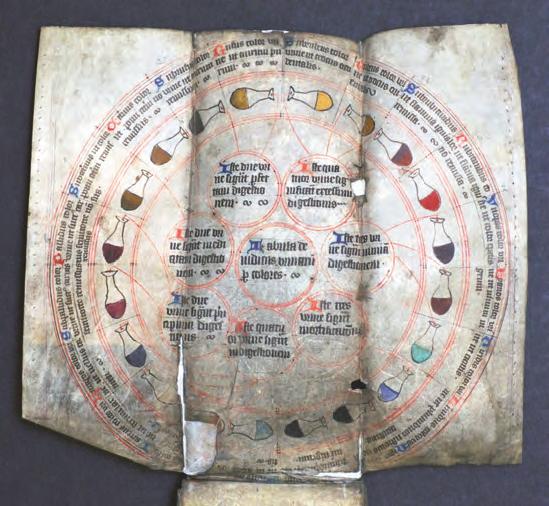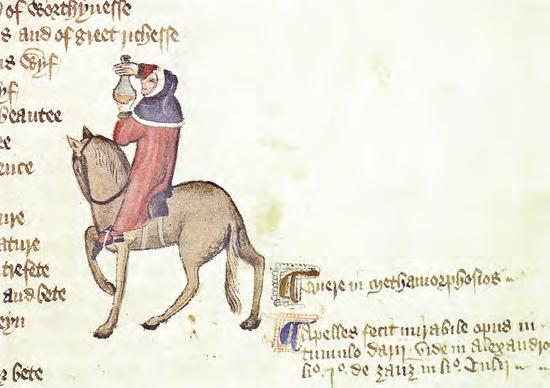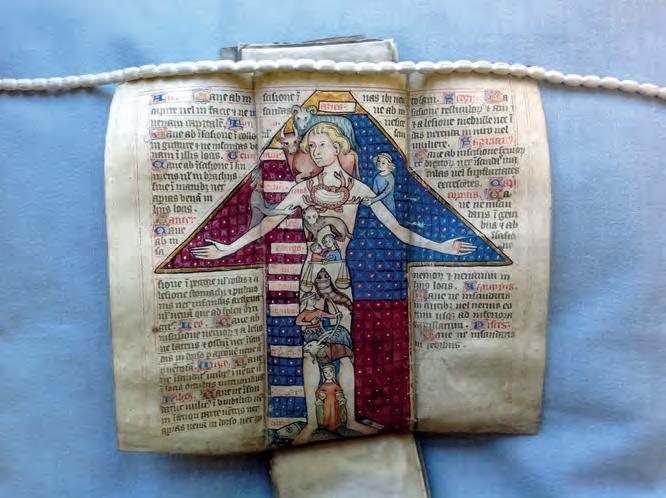
9 minute read
The Art of the Physician: Pepys MS 1662: M E J Hughes
the art of the physician
PEPYS MS 1662
Advertisement
Slipcase (21.5 x 7.5 cms): MS PL 1662 One of the strangest-looking items collected by Samuel Pepys is now preserved in his Library as MS PL 1662. It is also one of the oldest, dating from the early fifteenth century: a manuscript written on parchment in a formal clear book hand. To extract the manuscript from its oblong, scored leather (cuir ciselé) case is itself something of a palaver: a small hole at the pointed end admits a tentative finger with which to ease the contents out. The sheets of parchment which emerge are loosely bound at just one point, using stitching of thick string, with the binding reinforced by a scrap of leather. This creates a packet, something reminiscent of a small swatch of carpet samples. Then each of the ten fragile sheets is itself folded and must be opened out to form a triptych. Clearly meant to be carried about in the pocket or perhaps on a belt, the manuscript (which is about the size of a small Filofax) is functional. Calendars, lists and tables cover the sheets; but it is the final leaf which most graphically reveals the purpose of this object: a drawing of a circle comprising twenty small decanters, each coloured and arranged from white through increasingly dark shades of yellow to red, purple and finally, to black. ‘Iste tres urine significant mortificationem’ is inscribed next to the final, black vessel: if your urine is this colour, you are in serious trouble. 1
1 A detailed description of the appearance of this manuscript is provided in the Catalogue of the Pepys Library, vol V.i, compiled by Rosamund McKitterick and Richard Beadle.
Circular table illustrating urine (leaf x)
An almanac such as this, complete with urine circle, was an important piece of kit for the medieval doctor: in the Ellesmere manuscript of Chaucer’s Canterbury Tales, the Physician is pictured on horseback precariously holding a giant vessel containing some patient’s specimen – an oversized and emblematic representation of medieval medical practice rather than a realistic one perhaps; though holding up the sample to the light for examination was, indeed, the first thing a medieval physician would have done, followed by smelling. The shape of the vessel in which the specimen was examined was important: in both Pepys’s almanac and the Ellesmere manuscript, the decanter is shown to be bladder-like, thus permitting the urine to retain its natural configuration within its container.
Apart from the balance of the humours (associated with blood, yellow bile, black bile, and phlegm) the main factor which affected the colour of urine according to medieval medicine was the digestion: pale urine was undercooked, darker urine overcooked, with golden as the ideal – in a talismanic way, one could gain a golden prognosis by proffering gold to the doctor. A good example of undercooked urine was the very plentiful, thin, clear stuff produced by ‘the pissing evil’, diabetes. It essentially indicated a failure of the digestive and retentive powers of the body. Overcooked urine was a sign of too much digestion, although the doctor might be misled here. As the great twelfth-century diagnostician Gilles of Corbeil explained in a treatise which – along with the writings of John

of Arderne – became the basis for many subsequent treatments of the topic of urine (including Pepys’s almanac), the same symptoms might appear in a healthy body after too much dancing, sexual activity, running or other immoderate exercise. Seek balance in your life-style, says Gilles, prudently. 2
In the Ellesmere manuscript, Chaucer’s physician might have been holding the specimen up to the light to check the colour; but he might also have been concerned about another important feature to be observed: the bits and pieces floating in the urine. Up to nineteen different sorts of foreign body could be identified according to Gilles. There were sediments and oils, flakes and dust particles, bubbles and gravel. Those things which floated to the top signified problems with the head, those which sank revealed conditions of the feet and legs. Inspecting colours, matter and texture was a fine art. In a Middle English treatise on urine, a copy of which was also collected by Pepys (MS PL 878), there are many descriptive moments: ‘yf uyrne be blew (blue) and full of small motes as ben in the sunne-beame it betokyneth the goute that is in the feet’. And epithets conjure up evocative images: red urine is ‘like the oriental crocus’, yellow reminds one of ‘lemon fruits’. 3
The Physician, from Chaucer’s Canterbury Tales, MS EL 26 C 9 (fol 133). Reproduced by permission of the Huntington Library, San Marino, California.

2 Edward Grant, ed, A Source Book in Medieval Science (Cambridge, MA: Harvard University Press, 1974), pp 748–50. 3 On the colour descriptions in urine circles, see Stephanie Zaun’s article in Ingrid Bennewitz and Andrea Schindlker, eds, Farbe im Mittelalter, II (Berlin, 2011), pp 969–85.
With us ther was a DOCTOUR of phisik In al this world ne was ther noon hym lik, To speke of phisik and of surgerye, For he was grounded in astronomye. He kepte his pacient a ful greet deel In houres, by his magyk natureel.
So says Chaucer of his Physician in the ‘General Prologue’. To assess a patient’s condition and keep them alive a while longer did not require supernatural magical skills, but ‘magic natural’ – that is, science. The physician was a professional, who had learned a craft. The epitome of training grounds was Salerno, where the most up-to-date medicine was practised, and where Gilles of Corbeil studied in the 1160s. (When Burnellus, the anti-heroic donkey of the medieval satiric epic Speculum stultorum [A Mirror for Fools] looks for treatment for his embarrassingly short tail, he heads straight across the Apennines to Salerno.) Among the most famous teachers at Salerno was Roger, who produced a magnificently illustrated treatise on surgery, with operations for everything from arrow wounds to haemorrhoids, from cataracts to appendicitis; and there was an intriguing and shadowy woman known as Trotula who was reputed to be one of the great teachers. Gradually, the practices of the famous school, heavily influenced by Arabic medicine, spread across Europe, and the specialised language of diagnostics became available equally to experts and quacks.
By the 1400s, the science of medicine, with its mix of astrology and empirical observation, was part of everyday life. The two are linked visually in the Pepys Library almanac in a superb version of the so-called ‘zodiac man’, a yellow-haired figure with each astrological sign drawn on that part of the body which it affected: so, for example, Aries is depicted on the head, Aquarius on the legs and Cancer on the chest. Thus when the sign in the ascendant is Cancer, the doctor is warned: ‘Cave ab inscisione in pectore vel costis et a lesione stomachi et pulmonis nec inscindas artleriam vel venam que ad splen dirigitur’ [Be careful making an incision in the chest or the ribs or injury to the stomach or lung and don’t cut the artery or the vein running to the spleen]. The concentration on incisions is a key to how these warnings would apply – they often refer to the practice of bloodletting or phlebotomy.
It is not known how or why Pepys acquired this manuscript. It is not listed among those he possessed in 1694 (in that year he sent a list to be included in the catalogue of manuscripts in Britain and Ireland being compiled by the Savilian Professor of Astronomy at Oxford, Edward Bernard); and so it might be plausibly inferred that he bought the almanac some time after that date. Equally, one might speculate about how PL 1662 sits alongside Pepys’s contemporary scientific collection – his copy of Hooke’s Micrographia, with its ground-breaking drawings of animals hugely magnified, or Newton’s Principia Mathematica, on which Pepys’s imprimatur appears as the President of the Royal Society which commissioned the book.
‘Zodiac man’ (leaf vii)
Medical writings were always popular in the seventeenth century, and even before acquiring his own medieval almanac, Pepys might have been familiar with a similar one (though with a more distinctively agrarian element than PL 1662) which was owned by the first president of the (pre-charter) Royal Society, Sir Robert Moray, a man whom Pepys admired for both his science and his knowledge of music. Moray’s gift to the society in 1668, that almanac is now Royal Society manuscript 45. Moray, who ran the royal laboratories, showed Pepys around on at least one occasion: ‘Then down with Lord Broukner to Sir R. Murray into the King’s little elaboratory under his closet, a pretty place, and there saw a great many Chymicall glasses and things, but understood none of them’. 4 Perhaps Pepys and Moray shared an interest in medieval medical textbooks.
It seems highly likely that Pepys’s interest in acquiring the medieval medical almanac was more than antiquarian; with his constant agonies in earlier life from the bladder-stone, he had seen his fair share of urologists and was not averse to collecting advice on the alleviation of his symptoms wherever he could. In his Diary for 1663, he recounts two cures recommended for his condition: ‘Castle Sope in a posset’ [Castile Soap], and turpentine pills, which proved hard to

4 R Latham & W Matthews, eds, The Diary of Samuel Pepys, 11 vols (1970-83), vol 9, pp 415–16 (15th January 1669).
swallow. In his medieval almanac, as well as the several treatises on urine in his library, he would have found more suggestions including observing the phases of the moon, changing his diet and palpating the abdomen, eliding the fantastic with the scientific. It is easy now to think of medieval medicine as superstitious or wrong-headed, but there is no evidence that Pepys or Moray thought this. It is worth noting that when Pepys underwent his operation for the stone, the procedure was absolutely identical to that outlined in the thirteenth-century treatises on surgery, from the provision of raw egg to cleanse the wound through to the location of strapping to immobilise the subject. 5 And, like many medieval patients, he survived.
At a time when there was no anaesthetic and few ways to control infection, there was really no point in being sniffy about medieval science with its holistic determination to understand both bodies and beliefs. In 1665 Pepys expresses his surprised pleasure at having been free of a cold for months: favouring equally science and superstition, he attributes this both to those indigestible turpentine pills and to his talismanic hare’s foot. M E J H
5 Eldridge Campbell and James Colton, eds, The Surgery of Theodoric ca. A.D. 1267 (New York: AppletonCentury-Crofts, 1960), vol 2, pp 119–32.








